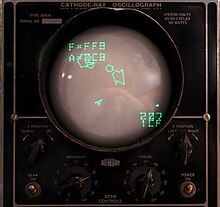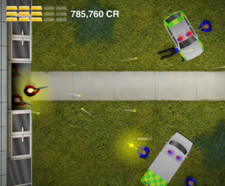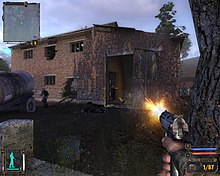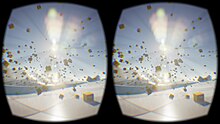How To Change Display Settings On Ps3 Blind
A variety of computer graphic techniques accept been used to display video game content throughout the history of video games. The predominance of private techniques have evolved over time, primarily due to hardware advances and restrictions such every bit the processing ability of key or graphics processing units.
Text-based [edit]
Some of the earliest video games were text games or text-based games that used text characters instead of bitmapped or vector graphics. Examples include MUDs (multi-user dungeons), where players could read or view depictions of rooms, objects, other players, and actions performed in the virtual world; and roguelikes, a subgenre of office-playing video games featuring many monsters, items, and environmental effects, as well equally an emphasis on randomization, replayability and permanent death. Some of the primeval text games were developed for estimator systems which had no video display at all.
Text games are typically easier to write and require less processing power than graphical games, and thus were more common from 1970 to 1990. However, terminal emulators are all the same in employ today, and people continue to play MUDs and explore interactive fiction. Many outset programmers still create these types of games to familiarize themselves with a programming linguistic communication, and contests are still held even today on who tin can finish programming a roguelike inside a short time period, such every bit seven days.[one]
Vector graphics [edit]

Vector graphics refer to the use of geometrical primitives such equally points, lines, and curves (i.e., shapes based on mathematical equations) instead of resolution-dependent bitmap graphics to represent images in computer graphics. In video games this type of projection is somewhat rare, but has become more common in recent years in browser-based gaming with the appearance of Flash and HTML5 Canvas, every bit these support vector graphics natively. An earlier example for the personal estimator is Starglider (1986).
Vector game can also refer to a video game that uses a vector graphics brandish capable of projecting images using an electron beam to draw images instead of with pixels, much similar a laser bear witness. Many early arcade games used such displays, as they were capable of displaying more than detailed images than raster displays on the hardware available at that time. Many vector-based arcade games used total-color overlays to complement the otherwise monochrome vector images. Other uses of these overlays were very detailed drawings of the static gaming environment, while the moving objects were fatigued by the vector beam. Games of this type were produced mainly by Atari, Cinematronics, and Sega. Examples of vector games include Asteroids, Armor Attack, Aztarac, Eliminator, Lunar Lander, Space Fury, Space Wars, Star Trek, Tac/Scan, Storm and Zektor. The Vectrex home console also used a vector display. After 1985, the use of vector graphics declined substantially due to improvements in sprite technology; rasterized 3D Filled Polygon Graphics returned to the arcades and were so popular that vector graphics could no longer compete.[2]
Full motion video [edit]
Full motion video (FMV) games are video games that rely upon pre-recorded tv- or movie-quality recordings and animations rather than sprites, vectors or 3D models to display action in the game. FMV-based games were popular during the early 1990s as CD-ROMs and Laserdiscs made their way into the living rooms, providing an culling to the low-capacity ROM cartridges of most consoles at the time. Although FMV-based games did manage to look amend than many contemporary sprite-based games, they occupied a niche market; and a vast majority of FMV games were panned at the fourth dimension of their release, with many gamers citing their dislike for the lack of interaction inherent in these games. As a upshot, the format became a well-known failure in video gaming, and the popularity of FMV games declined substantially after 1995 as more advanced consoles started to get widely available.
A number of unlike types of games utilized this format. Some resembled modern music/dance games, where the player timely presses buttons according to a screen instruction. Others included early rails shooters such every bit Tomcat Alley, Surgical Strike and Sewer Shark. Total motion video was also used in several interactive film adventure games, such every bit The Creature Within: A Gabriel Knight Mystery and Phantasmagoria.
2nd [edit]
Games utilizing parallel project typically make use of two-dimensional bitmap graphics every bit opposed to 3D-rendered triangle-based geometry, allowing developers to create large, complex gameworlds efficiently and with relatively few art assets past dividing the fine art into sprites or tiles and reusing them repeatedly (though some games utilise a mix of unlike techniques).

An example of a typical meridian-down, third-person view game, The Heist two
Top-downwards perspective [edit]
Top-downwardly perspective, also sometimes referred to as bird's-eye view, Overworld, Godview, overhead view, or helicopter view, when used in the context of video games, refers to a camera bending that shows players and the areas around them from higher up. While non sectional to video games utilizing parallel project, it was at once common amid 2D part playing video games, wargames, and construction and direction simulation games, such as SimCity, Pokémon, and Railroad Tycoon; also as amongst action and activeness-take chances games, such as the early The Legend of Zelda and M Theft Auto games.
Side-scrolling game [edit]

A side-scrolling game or side-scroller is a video game in which the viewpoint is taken from the side, and the onscreen characters by and large can just movement, to the left or right. Games of this type make utilize of scrolling calculator display engineering science, and sometimes parallax scrolling to suggest added depth.
In many games the screen follows the player character such that the thespian character is always positioned nearly the center of the screen. In other games the position of the screen volition change co-ordinate to the player character's movement, such that the player character is off-eye and more than space is shown in forepart of the character than behind. Sometimes, the screen will scroll not merely frontwards in the speed and management of the player graphic symbol's movement, but also backwards to previously visited parts of a stage. In other games or stages, the screen will simply gyre forrad, not backwards, so that once a stage has been passed it tin no longer be visited. In games such as shoot 'em ups similar R-type, the screen scrolls forward by itself at a steady rate, and the player must keep upwards with the screen, attempting to avoid obstacles and collect things before they pass off screen.
Examples of side-scrolling games include platform games such every bit Sonic the Hedgehog and Ori and the Blind Forest, beat 'em ups such as the pop Double Dragon and Battletoads, and shooters such every bit R-Type and (more recently) Jets'northward'Guns. The Super Mario Bros. series has used all iii types of side-scrolling at some fourth dimension in its history.
2.5D, 3/4 perspective, and pseudo-3D [edit]
2.5D ("two-and-a-half-dimensional"), three/4 perspective and pseudo-3D are breezy terms used to depict graphical projections and techniques that endeavor to "false" three-dimensionality, typically by using some grade of parallel projection, wherein the point of view is from a fixed perspective, but also reveals multiple facets of an object. Examples of pseudo-3D techniques include isometric/axonometric projection, oblique projection, orthographic projection, billboarding, parallax scrolling, scaling, skyboxes, and skydomes. In improver, 3D graphical techniques such as bump mapping and parallax mapping are ofttimes used to extend the illusion of 3-dimensionality without substantially increasing the resulting computational overhead introduced by larger numbers of polygons (a.thou.a. the "polygon count").
These terms sometimes possess a 2nd pregnant, wherein the gameplay in an otherwise 3D game is forcibly restricted to a 2-dimensional aeroplane.
Examples of games that make use of pseudo-3D techniques include Zaxxon, The Sims and Diablo (isometric/axonometric projection); Ultima 7 and Paperboy (oblique projection); Sonic the Hedgehog and Street Fighter Two (parallax scrolling); Fonz and Space Harrier (scaling); and Half-Life 2 (skyboxes). In improver to axonometric project, games such equally The Sims and Final Fantasy Tactics also brand use of a combination of pre-drawn second sprites and real-time polygonal graphics instead of relying entirely on 2d sprites every bit is the norm.
3D [edit]
With the advent of 3D accelerated graphics, video games could expand across the typically sprite-based 2d graphics of older graphics technologies to describe a view frequently more true to reality and lifelike than their predecessors. Perspective projection has also been used in some before titles to nowadays a 3D view from a fixed (and thus somewhat less hardware-intensive) perspective with a limited ability to motion.
Voxel engines [edit]
Contrary to using triangle meshes, this uses Voxels.
Fixed 3D [edit]
Fixed 3D refers to a 3-dimensional representation of the game earth where foreground objects (i.e. game characters) are typically rendered in real time against a static background. The master advantage of this technique is its ability to display a high level of detail on minimal hardware. The principal disadvantage is that the actor'south frame of reference remains fixed at all times, preventing players from examining or moving about the environment from multiple viewpoints.
Backgrounds in fixed 3D games tend to be pre-rendered two-dimensional images, but are sometimes rendered in real time (e.g. Blade Runner). The developers of SimCity 4 took advantage of stock-still perspective by not texturing the reverse sides of objects (and thereby speeding upward rendering) which players could not meet anyway.[iii] Fixed 3D is also sometimes used to "simulated" areas which are inaccessible to players. The Legend of Zelda: Ocarina of Fourth dimension, for instance, is nigh completely 3D, but uses fixed 3D to represent many of the building interiors besides as one entire town (this technique was later dropped in favor of total-3D in the game's successor, The Legend of Zelda: Majora's Mask). A similar technique, the skybox, is used in many 3D games to represent distant background objects that are not worth rendering in existent fourth dimension.
Used heavily in the survival horror genre, fixed 3D was first seen in Infogrames' Alone in the Night series in the early 1990s and imitated past titles such as Ecstatica. It was later on brought back by Capcom in the Resident Evil series. Gameplay-wise there is little deviation betwixt fixed 3D games and their 2D precursors. Players' ability to navigate within a scene still tends to be limited, and interaction with the gameworld remains mostly "point-and-click".
Further examples include the PlayStation-era titles in the Final Fantasy series (Square); the office-playing games Parasite Eve and Parasite Eve II (Square); the action-risk games Ecstatica and Ecstatica 2 (Andrew Spencer/Psygnosis), too as Little Large Adventure (Adeline Software International); the graphic adventure Grim Fandango (LucasArts); and 3D Movie Maker (Microsoft Kids).
Pre-rendered backgrounds are also found in some isometric video games, such as the role-playing game The Temple of Elemental Evil (Troika Games) and the Baldur's Gate series (BioWare); though in these cases the form of graphical projection used is not different.
First-person perspective [edit]

Commencement person refers to a graphical perspective rendered from the viewpoint of the player grapheme. In many cases, this may exist the viewpoint from the cockpit of a vehicle. Many different genres have made utilize of first-person perspectives, including run a risk games, flight simulators, and the highly popular showtime-person shooter genre.
Games with a first-person perspective are usually avatar-based, wherein the game displays what the player'due south avatar would run into with the avatar'due south ain optics. In many games, players cannot see the avatar's trunk, though they may be able to see the avatar'south weapons or hands. This viewpoint is also frequently used to correspond the perspective of a driver within a vehicle, equally in flying and racing simulators; and it is mutual to make utilise of positional sound, where the volume of ambient sounds varies depending on their position with respect to the player'southward avatar.[iv]
Games with a first-person perspective do not require sophisticated animations for the player's avatar, and do not need to implement a manual or automatic camera-control scheme as in third-person perspective.[four] A outset person perspective allows for easier aiming, since there is no representation of the avatar to cake the player's view. Notwithstanding, the absenteeism of an avatar tin can make information technology difficult to master the timing and distances required to jump between platforms, and may cause motion sickness in some players.[4]
Players have come to expect first-person games to accurately scale objects to advisable sizes. However, key objects such as dropped items or levers may be exaggerated in society to improve their visibility.[4]
Third-person perspective [edit]
Third person refers to a graphical perspective rendered from a view that is some distance abroad (normally behind and slightly higher up) from the player's graphic symbol.[4] This viewpoint allows players to see a more strongly characterized avatar, and is most common in action and action-adventure games.[iv] This viewpoint poses some difficulties, however, in that when the actor turns or stands with his back to a wall, the camera may jerk or end up in awkward positions. Developers have tried to alleviate this event past implementing intelligent camera systems, or by giving the actor control over the photographic camera.[4] There are three primary types of third-person camera systems: "fixed camera systems" in which the photographic camera positions are set during the game cosmos; "tracking camera systems" in which the camera but follows the thespian'due south character; and "interactive camera systems" that are under the player's command.
Examples of games utilizing tertiary-person perspective include Super Mario 64, the Tomb Raider series, the 3D installments of the Legend of Zelda serial, and Crash Bandicoot.
Other topics [edit]
Stereo graphics [edit]
Stereoscopic video games use stereoscopic technologies to create depth perception for the actor by any form of stereo display. Such games should not to exist confused with video games that utilize 3D computer graphics, which although they feature graphics on screen, exercise non requite the illusion of depth across the screen.
Virtual reality headset [edit]

Image captured from Oculus Rift DK2, showing compensation for lens distortion and chromatic aberration.
The graphics for virtual reality gaming consist of a special kind of stereo 3D graphics to fit the upwards-close display. The requirements for latency are also higher to reduce the potential for virtual reality sickness.
Multi-monitor setup [edit]
Many games tin run multi-monitor setups to achieve very loftier display resolutions. Running games in this style tin can create a greater sense of immersion, e.g. when playing a video racing game or flight simulator or requite a tactical advantage due to the higher field of view.
Augmented/Mixed reality graphics [edit]
Augmented or mixed reality game graphics employ images that partial overlay the image of reality seen through partial transparent glasses or captured with a camera and seen with a head-mounted display or other displays such as smartphone or tablet displays.
See besides [edit]
References [edit]
- ^ "7DRL - RogueBasin". Roguebasin.roguelikedevelopment.org. 2022-05-12. Retrieved 2011-11-22 .
- ^ Wolf, Mark J. P. (2008). The video game explosion: a history ... - Mark J. P. Wolf - Google Books. ISBN9780313338687 . Retrieved 2011-xi-22 .
- ^ Pedriana, Paul. "Is SimCity 4 3D?". Maxis. Retrieved 2009-01-fourteen .
- ^ a b c d eastward f g Rollings, Andrew; Ernest Adams (2006). Fundamentals of Game Design. Prentice Hall.
How To Change Display Settings On Ps3 Blind,
Source: https://en.wikipedia.org/wiki/Video_game_graphics
Posted by: elmeralds1960.blogspot.com


0 Response to "How To Change Display Settings On Ps3 Blind"
Post a Comment